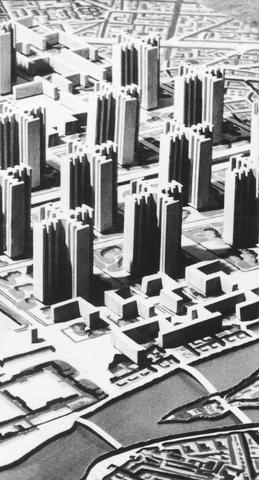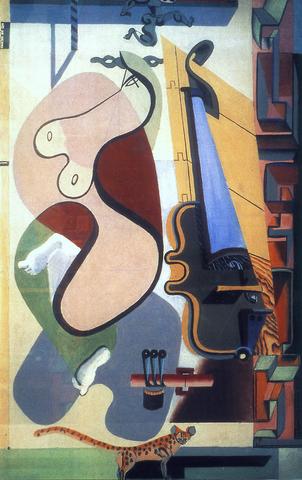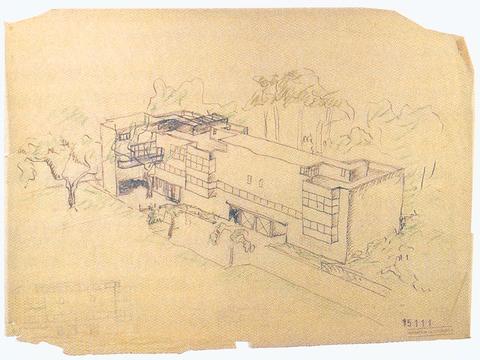Le Corbusier may be one of the 20th century's greatest architects, but few know that he spent the first 33 years of his life as a painter, interior designer and factory manager. A new exhibition at the Taipei Fine Arts Museum (TFAM), Le Corbusier: Morceaux Choisis, 1912-1965, takes this lesser known, non-architectural side of the architect and confronts it with scores of elevations, plans, sketches and models of his famous "white houses," the church at Ronchamps and other contributions to the architecture textbooks. Thus the opus of the revered master, which is already so well known, is endowed with the context of the ideas underlying it, architectural and otherwise. It is unlikely that such a provoking, in-depth look at this modernist visionary will ever come through Taiwan again.
Even more special, the show was exclusively created for TFAM. Unlike travelling exhibitions that local museums usually have to purchase, Morceaux Choisis(which roughly translates as "Selected Fragments") was uniquely conceived for display in Taipei by curator Jacques Sbriglio, who drew every document, model and canvas -- several 80-years-old or more -- from the archives of the Fondation Le Corbusier in Paris. Once the exhibition is over, the works will return to hibernation in France.
Le Corbusier will forever be known as the inventor of an architecture for the industrial age. He believed in pure geometrical forms and designed cheap, modular structures of ferroconcrete that could be mass produced. He designed buildings with internal supports that freed the walls from having to hold up the roof, so for the first time, exteriors were striped with bands of horizontal windows. These are the tools he used to form his rigidly conceived, white boxes.

Not just an architect, Le Corbusier was also a socialist and a utopian, and his maxim went: "the house is a machine for living in." And like all of the modern uptopians, his belief in unlimited social progress through technology was to prove wrong. At one point he suggested a plan to raze part of Paris, replacing it with 18 mega-skyscrapers, each surrounded by a huge, hygenic buffer of parks and gardens. Such ideas eventually came to fruition in the hands of others through structures like the public housing projects of the US and the workers' dormitories of the Eastern Block ? depressing monuments to conformist living. But if Le Corbusier's vision of life in the modern age was cold and authoritarian, he still introduced ideas on how to accommodate mass-produced living that others were later able to adapt and make more human.
Born Charles-Edouard Jeanneret in Switzerland in 1887, it wasn't until the age of 33 that he adopted his maternal grandfather's name, Le Corbusier, to distinguish his architectural work from his painting. By then he had already been in Paris for four years, where art was already in the process of dissecting both the real and visual worlds. The Fauves had already made painting unnatural, the Cubists were breaking forms, and the Dada movement was both embracing machine age aesthetics and introducing a psychological perspective that would give way to the violent emotions of the Expressionists and the dream fascination of the Surrealists.
Morceaux Choisis begins with Le Corbusier's two dimensional works of this period. Watercolors and paintings of the early 1910s are those of a young artist, eclectic and searching through the various styles of his time. Towards the end of the 1910s he starts to find himself in a more determined brand of Cubism, in which he simplifies natural objects, mostly still lifes, into a purified geometry of regular shapes, angles and curves. It is quite different from the shattered fragments found in the analytic cubism of his contemporaries Georges Braque and Pablo Picasso.

Fondation Le Corbusier director Evelyn Trehin cites Le Corbusier's closest painting influence as Fernand Leger, whom Le Corbusier met in 1920. Both moved out of Cubism looking for a more pure geometry, one that Le Corbusier found everywhere from the Parthenon in Athens, with its round columns, rectangular plan and triangular pediments to the new clear-cut geometry of the automobile.
In 1922, Le Corbusier built his first white box, the Maisons Citrohan. In that and other designs -- the Villa Savoy (1928) and the more massive and severe Unite d'Habitation (1945) -- the principles applied are reflected in his paintings. Natural forms are simplified and compartmentalized into a purist's geometry; only the most basic forms are used.
But over a lifetime, Le Corbusier's ideas softened. Later paintings, which date as late as 1956 in the exhibition, show more irregular shapes, broken lines and a new vocabulary of curves. Likewise, his Notre Dame du Haut at Ronchamps (1951), which is perhaps his masterpiece, is a structure consisting predominantly of warped forms and irregular geometry.

In viewing Morceaux Choisis, it is hard not to see these similarities and make these kinds of comparisons. Yet to the curator's credit, he has not imposed his own decisions on how exactly these marvelous and seldom seen fragments of Le Corbusier's past are to form a congruous whole. In the exhibition space, architecture forms one cycle, and painting another. Connections may be drawn, or not.
Le Corbusier: Morceaux Choisis, 1912-1965 opened yesterday and is on display through Oct. 27.


When Taiwan was battered by storms this summer, the only crumb of comfort I could take was knowing that some advice I’d drafted several weeks earlier had been correct. Regarding the Southern Cross-Island Highway (南橫公路), a spectacular high-elevation route connecting Taiwan’s southwest with the country’s southeast, I’d written: “The precarious existence of this road cannot be overstated; those hoping to drive or ride all the way across should have a backup plan.” As this article was going to press, the middle section of the highway, between Meishankou (梅山口) in Kaohsiung and Siangyang (向陽) in Taitung County, was still closed to outsiders

US President Donald Trump may have hoped for an impromptu talk with his old friend Kim Jong-un during a recent trip to Asia, but analysts say the increasingly emboldened North Korean despot had few good reasons to join the photo-op. Trump sent repeated overtures to Kim during his barnstorming tour of Asia, saying he was “100 percent” open to a meeting and even bucking decades of US policy by conceding that North Korea was “sort of a nuclear power.” But Pyongyang kept mum on the invitation, instead firing off missiles and sending its foreign minister to Russia and Belarus, with whom it

President William Lai (賴清德) has championed Taiwan as an “AI Island” — an artificial intelligence (AI) hub powering the global tech economy. But without major shifts in talent, funding and strategic direction, this vision risks becoming a static fortress: indispensable, yet immobile and vulnerable. It’s time to reframe Taiwan’s ambition. Time to move from a resource-rich AI island to an AI Armada. Why change metaphors? Because choosing the right metaphor shapes both understanding and strategy. The “AI Island” frames our national ambition as a static fortress that, while valuable, is still vulnerable and reactive. Shifting our metaphor to an “AI Armada”

The Chinese Communist Party (CCP) has a dystopian, radical and dangerous conception of itself. Few are aware of this very fundamental difference between how they view power and how the rest of the world does. Even those of us who have lived in China sometimes fall back into the trap of viewing it through the lens of the power relationships common throughout the rest of the world, instead of understanding the CCP as it conceives of itself. Broadly speaking, the concepts of the people, race, culture, civilization, nation, government and religion are separate, though often overlapping and intertwined. A government